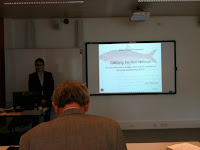The Difference Between Email and Social Bookmarking
Well, Arzu just finished her Masters thesis last week with a good grade! As you know I posted several snippets from her work. Soon her thesis will be public for you to read. I think she did a really good job and the results, though focussed on social bookmarking, are interesting in general if you're interested in technology and social media adoption.
But how do you share bookmarks? Do you use a social bookmarking tool? My experience is not many people use a social bookmarking tool. Of course they bookmarks stuff and save the bookmarks in their browser. Hardly anyone knows you can share them publicly as well.
At least that's the experience I have. I give workshops about social media and I always have a slide about bookmarking. I've been tempted to leave it out. Because every time I get to that slide and ask how many of them know what social bookmarking is and use it, hardly anybody does. The ratio is 1-2 out of every 10 workshop participants.
Is this the reason why Delicious, Xmarks and the like have a hard time? I think so... Most people keep their bookmarks private and share them via email if they're interesting enough. Of course, lots of links are shared (but not stored...) via Twitter.
So, we have work to do. Again it shows social media maybe easy to use, but not always easy to understand and adopt. Training and explaining is necessary. I like the way Arzu explains the difference between email and social bookmarking:
Anyway, I'm not giving up my bookmarking tool Diigo any time soon. Just hope they will keep their head up!
What are your experiences with social bookmarking? Are you using a tool? If not, how do you collect and share bookmarks?
But how do you share bookmarks? Do you use a social bookmarking tool? My experience is not many people use a social bookmarking tool. Of course they bookmarks stuff and save the bookmarks in their browser. Hardly anyone knows you can share them publicly as well.
At least that's the experience I have. I give workshops about social media and I always have a slide about bookmarking. I've been tempted to leave it out. Because every time I get to that slide and ask how many of them know what social bookmarking is and use it, hardly anybody does. The ratio is 1-2 out of every 10 workshop participants.
Is this the reason why Delicious, Xmarks and the like have a hard time? I think so... Most people keep their bookmarks private and share them via email if they're interesting enough. Of course, lots of links are shared (but not stored...) via Twitter.
So, we have work to do. Again it shows social media maybe easy to use, but not always easy to understand and adopt. Training and explaining is necessary. I like the way Arzu explains the difference between email and social bookmarking:
In the e-mail case, the provider anticipates who is seeking or in need of the specific knowledge as a result of inter-personal relationships and therefore intentionally pushes the information through to the recipient. In the social bookmarking case, the provider shares bookmarks without knowing who the receiver is and who might be in need of specific knowledge. In such a case, communication streams are pull-based rather than push-based. The difference between pull and push has two implications for the social bookmarking tool: potential seekers perceive the information in the social bookmarking tool as information overload and potential providers ask for a balance between these two mechanisms. Balancing pull and push processes will optimize the knowledge flow and overcome the problem of information overload by providing people with both awareness of and access to what they need (Alavi & Leidner, 2001; Holtshouse, 1998).Maybe this points to a design flaw in most social bookmarking tools? Is telling you who's reading your shared bookmarks an improvement? (You can follow each other's bookmarks in most social bookmarking tools.)
Anyway, I'm not giving up my bookmarking tool Diigo any time soon. Just hope they will keep their head up!
What are your experiences with social bookmarking? Are you using a tool? If not, how do you collect and share bookmarks?



